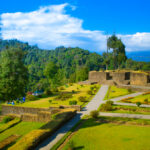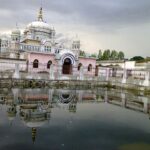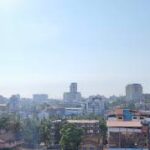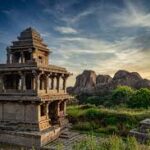Now Reading: Top 5 Best Places Visiting in Sheopur – Forts, Wildlife & Cultural Gems
-
01
Top 5 Best Places Visiting in Sheopur – Forts, Wildlife & Cultural Gems

Top 5 Best Places Visiting in Sheopur – Forts, Wildlife & Cultural Gems
1.Kuno National Park

Blessed with innumerable wildlife sanctuaries as well as the greeneries, Madhya Pradesh has emerged out to be a pioneering place in the world for wildlife and conservation enthusiast, as much beautiful Kuno National Park which located in the heart of Madhya Pradesh. Stretching over 344.686 km, this park provides a comprehensive combination of rich flora, fauna and landscape as well as its historical value.
Kuno National Park is place located on sheopur disst of Madhya pradesh. It is located in the northernmost part of the Vindhyachal mountain range, the area of which is known for the terrific terrain, thicket and twisting rivers. The park is called from the Kuno River, one of the tributories of the Chambal, along which the park and its full of varieties of ecosystem flow slowly in gentle tributaries of the life.
Initially set up as Kuno Wildlife Sanctuary, the territory was designated as national park in order to give a much stronger arrangement for the conservation of wildlife. Today it is the habitat of several endangered species and has been a major player in India’s conservation efforts.
Why Visit Kuno?
Kuno National Park is heaven for nature lovers, wildlife enthusiast and photographers. Apart from cheetahs, the park has:
- Leopards
- Sloth bears
- Indian wolves
- Hyenas
- Various species of deer and antelope
2.Baroda Fort

Bcoz Shiyopur doments an old city also you can see Baroda Fort which is somehow lies into the heart of History of Baroda. The massive structure was initially constructed by Duchi Rajo. It was then acquired later by King Indra Singh Gaur at the time which was incorporated into Shiyopur principality.
The history of Baroda Fort is characterized by tales of power, skill and vision and most importantly architecture. When King Indra Singh Gaur said that his commander Jyon had killed another commander against the walls of Amer, his king’s victory was not only a military victory but also an extension of his kingdom’s culture and politics in the region. The fort was then improved and turned into a renowned emblem of the Shiyopur kings
3.Manpur Fort

Hidden about 45 kilometers away from Sheopur stands tall Manpur Fort, a place that echoes power, devotion and changing hands over the years. Construido por Raja Mansingh, este fuerte es una orgullosa proclama de la región de su firme historia y rica herencia cultural.
Manpur Fort was built originally by the Raja Mansingh during his reign, but afterwards it fell into the hands of the Sheopur the Gaur Rajputs, a notable clan of the region. Later in 1809 The fort experienced a significant political change when Daulatrao Scindia a powerful Maratha king captured it. This conquest was a part of the larger strategy of the Scindias to gain their hold across Central India.
Spiritual and Artistic Treasures
- One special thing in the fort is their spiritual and artistic wealth. Inside the grounds is the revered Maneshwar Mahadev Temple, a point of worship that still draws in devotees looking for peace as well as historical wisdom.
- Just as fascinating is the paintings of Raga-Ragini enclosed in within the fort. While these works represent the classical Indian custom of correlating musical modes (ragas) with visible shapes, emotions, or even time of day or season, they were created to release sight and emotion. The inlaid artwork on fort walls provides an additional layer of art and culture to Manpur Fort, giving it a special place in comparison to other forts of that era.
4.Sahariya museum

Budding in the ancient fort walls of Sheopur in Madhya Pradesh is a remarkable cultural haven – Sahariya Museum, a unique centre that is dedicated to protect, preserve and promote the vibrant yet threatened culture of Sahariya, one of India’s most marginalized and ancient tribal communities.
To save the ancient tradition, language and life-style of Sahariya community, Sahariya Development Authority in association with Archeology and Culture Conservation Committee has established this museum as a repository cum research centre. The initiative aims to give a more concrete look into the tribe’s history, establish place for culture revival and academic learning.
5.Sheopur Fort

Sheopur Fort dominates the point where Sep flows into Kalval rivers to display India’s impressive cultural heritage in its magnificent design. The historic fort operates as a temporal gateway that conducts visitors through time to view stones with tales and artworks demonstrating the mastery of artists who made history.
This architectural structure holds a special place in history as one of a kind stone construction achievements. The traditional Indian architectural methods discovered in this structure have proven to be strong and enduring through time by displaying architectural excellence. The complex contains majestic stone carvings together with picturesque arches and courtyards which display royal life from centuries past.
The Archaeology Museum in the fort exhibits 425 statues and sculptures that preserve history for visitors. The museum displays carefully archived artifacts that reveal the diverse arts of this area including Hindu divinities together with royal sculptures and mythical designs.
Why You Should Visit
- The regal atmosphere of Sheopur Fort welcomes touristic exploration to visitors no matter what type of traveler they belong to. Visitors should experience this place because it goes beyond visuals into a historical journey where they can feel the vigorous energy of times past while observing masterpieces that remain awe-inspiring in the present day.
Related articles : Best Places Visiting in Shajapur – Temples, Forts & Cultural Landmarks
Stay Informed With the Latest & Most Important News
Previous Post
Next Post
-
 01Top 5 Best Places Visiting in Gyalshing – Monasteries, Lakes & Scenic Escapes
01Top 5 Best Places Visiting in Gyalshing – Monasteries, Lakes & Scenic Escapes -
 02Top 5 Best Places Visiting in Panna – Temples, Waterfalls & Wildlife Escapes
02Top 5 Best Places Visiting in Panna – Temples, Waterfalls & Wildlife Escapes -
 03Top 5 Best Places to Visit in Malerkotla – Malerkotla Fort, Sheesh Mahal & More
03Top 5 Best Places to Visit in Malerkotla – Malerkotla Fort, Sheesh Mahal & More -
 04Top 10 Best Places Visiting in Dakshina Kannad for Culture, Nature & Coastal Charm
04Top 10 Best Places Visiting in Dakshina Kannad for Culture, Nature & Coastal Charm -
 05Top 2 Best Places Visiting in Chitradurga for History, Nature & Adventure
05Top 2 Best Places Visiting in Chitradurga for History, Nature & Adventure -
 06Best Places Visiting in Shopian – Explore Top Attractions & Hidden Gems
06Best Places Visiting in Shopian – Explore Top Attractions & Hidden Gems -
 07Best Places Visiting in Narmadapuram – Temples, Waterfalls & Wildlife Escapes
07Best Places Visiting in Narmadapuram – Temples, Waterfalls & Wildlife Escapes














Pingback: Best Places Visiting in Shivpuri – Forts, Palaces & Natural Wonders